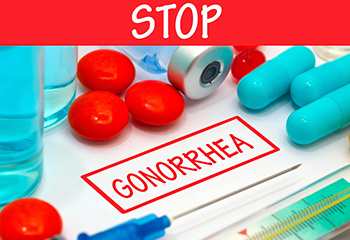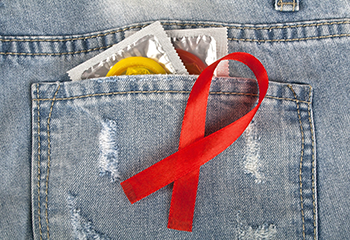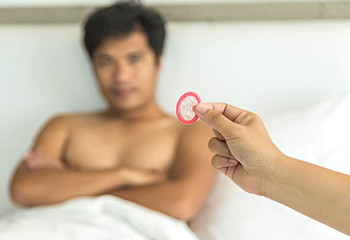
General information about STD and HIV
Sexual Transmitted Diseases (STDs) have been in existence for a very long time. With the availability of faster transportation options over the course of time, STD's spread all over the world. Spreading also increased when sexual norms and values changed and more sexual freedom was accepted. Anyone who is sexually active and who has (had) sex without a condom is at risk for getting an STD.
An STI (Sexually Transmitted Infection) is a condition caused by a pathogen that causes infection (e.g., Virus, bacteria, fungi, other parasites) The causes can usually be determined by an investigation. The disease can be transmitted through the penis and the vagina, but also through the mouth and anus, depending on how you have sex.
There are three groups of STD:
- SOA's with secretions (called thrush) and a burning sensation when passing urine (not in all women) e.g. gonorrhea, chlamydia
- SOA's with cuts, warts, or blisters, e.g. syphilis (chancre)
- SOA's in which the blood is infected with the virus, e.g. HIV (Human Immune Deficiency Virus)
The 15 most common STDs are:
 1.Gonorrhea (the clap)
1.Gonorrhea (the clap)
This STI is highly contagious and can be dangerous, even if the pain is not so bad and if there is little discharge. Women have few symptoms. Three days after infection, men usually have a thick pus from the urethra and a very burning sensation when urinating. If not treated on time, the epididymis in men can get an inflamed and in women, the ovaries can get severely inflamed.
2.Chlamydia
This STI also causes discharge but not as much as the clap. Many people who have this disease, notice no discharge, so the disease often left untreated. This results in serious internal infections, which can lead to infertility.
3.Trichomonas Vaginalis
This STI causes severe itching of the vulva (which is the entrance to the vagina) and a yellowish foamy discharge, especially in women. Men often have less discharge and only experience a burning sensation when urinating.
4.Bacterial vaginosis
Is a disturbance of the balance in the vagina, causing an excess of bacteria in the vagina which normally only occur in smaller amounts. The lactic acid bacteria have been displaced, disrupting the acidity in the vagina. The main complaint is the bad smelling discharge.
5.Genital Warts
Genital warts are caused by the human papillomavirus (HPV). Upon infection, with HPV you cannot always see warts. Especially in women, warts can sometimes be internal so they are not noticed. In most cases, HPV is found in cervical cancer. This means that a large proportion of cervical cancer cases can be prevented, by preventing infection with this STD.
6.Herpes Genitalis
Typically these STDs are sores or painful red spots around the genitals. This STD is caused by the herpes simplex virus type, 2.
Herpes patients have an average of 4 to 5 attacks per year. The symptoms can be treated, but the infected never loses more virus, it often returns.
7.Pubic lice
This condition is caused by small lice that live on the hairy parts of the body. The lice manifest themselves after being transferred within two weeks and cause itching. Pubic lice are transmitted through sexual contact, but sometimes also through other ways of intimate contact or through bed linen, clothing, and towels.
8.Hepatitis B
Hepatitis B is transmitted by a virus, which causes inflammation of the liver, causing severe damage to the liver itself. The virus is transmitted e.g. through blood, semen, and vaginal fluid but there are also known cases of contamination via non-sterile injection needles (from drug abuse).
9.Syphilis or chancre
This STD is caused by bacteria and is noticed as a not (very) painful wound on the penis or vulva. After a few days or weeks, the wound may disappear with, or without treatment. A few months later spots or patches appear on the body. During this time the infected person is highly infectious, even when not sexually intimate.(e.g. kissing) These spots will also disappear on their own if left untreated. The disease is not gone, but remains in the blood and can remain in the body for many years without you noticing. If it is not detected and treated on time, it may cause serious defects.
10.Candida Albicans
This is an infection caused by the yeast such as Candida. Men usually have no symptoms, sometimes they only experience redness of the penis glans. In women inflammation of the vagina and vulva occur. Redness, painful mucous membranes, and white grained, cheesy discharge.
11.Scabies
Scabies caused by a mite that creates passages under the skin and causes unbearable itch, especially during the night. There is a direct infection.

12.Soft chancre
Soft, red, very painful sores on the genitals and painful swollen inguinal lymph node.
13.Granuloma Inguinal
Raw, easy bleeding wounds on the genitals.
14.Lymphogranuloma (Crab Hole)
Significant inguinal lymph node swelling; usually without a wound on the genitals.
15.HIV (Human Immune Deficiency Virus)
HIV is the name of the virus which causes the disease AIDS. If you are infected with this virus, you are HIV positive. The virus breaks down the body's immune system and can, exist for a long time in the body live without the body getting sick. There is talk of AIDS, only if HIV has affected the immune system so that it cannot protect against diseases. .The HIV virus can be found in blood, semen, vaginal fluids, moisture pre-ejaculate, and milk. In other body fluids, the virus may be present, but in a much too low a concentration to be able to cause an infection. Thus, saliva, sweat, tears, urine, and feces are only dangerous if blood is visible and if there is a risk that this may directly enter the body.
HIV can be transmitted through:
- Unsafe sex:
As long as you have unsafe sex you are at risk of infection with HIV or other STDs. You cannot see if someone is HIV positive. This means safe sex. - Drug use:
Only if someone is injecting drugs with needles previously used by someone who has HIV he/she is at risk of an HIV infection. The HIV virus can enter the bloodstream this way. - Mother-child transmission:
HIV can be transmitted from an HIV-positive mother to the child during pregnancy or childbirth. After childbirth, the mother can also transmit the virus through breastfeeding. The risk of transmission can be reduced if the mother is treated with medications and if other precautions are taken during delivery.

- Blood contact:
You can also get infected if your blood comes into contact with HIV infected blood.
You cannot get STD’s and HIV if you:
- Have No Sex
- Use a Condom
- Cuddle, kiss, caress or massage
- Use the same toilet utensils (the virus cannot live in the open air)
- Breathe, cough, sneeze
- Get bitten by insects (a mosquito bite contains too little blood, to cause infection with the virus

De ABC method
De ABC method is is a method of preventing HIV / AIDS and stands for:
A- Abstinence: Avoiding any sexual activities that could cause transmission
B- Be faithfull: Avoiding sexual intercourse other than with a mutually faithful uninfected partner
C- Condomise: Correct and consistent use of condoms at every sexual encounter


